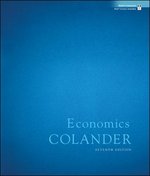Question
Question 6 : Consider a world with two countries, Home and Foreign, and two goods: manufactures and food. The production of manufactures requires capital and
Question 6 : Consider a world with two countries, Home and Foreign, and two goods: manufactures and food. The production of manufactures requires capital and labour whereas the production of food requires land and labour. Assume that both countries are identical in all aspect but their endowments of capital. In particular, assume that both countries have one unit of land, T = 1, but Home has one unit of capital, K =1, and Foreign has three units of capital: K* = 3. The technologies to produce manufactures and food are the same in both countries and given by: QM=4K1/2(LM)1/2 QF=2T 1/2(LF)1/2 Answer the following questions: [HINT: the MPL curve for a production function of the form Q=ABaLb is given by MPL=bABaLb-1 where A, a, b are constants, and B = K, T.] Assume that the relative demand for manufactures is given by: RD=50-(PM / PF).
a) Use the equilibrium in the labour market to write the demand for labour in manufactures and food in each country,LM, LF, L*M, L*F, in terms of the relative price of manufactures in each country, PM/PF and P*M/P*F.
b) Use the expressions obtained in a) to write the relative supply of manufactures in each country,RS = QM/QF and RS* = Q*M/Q*F, as a function of the relative price of manufactures. Plot them in the same RS-RD diagram (put relative prices in the y-axis and relative quantities in the x-axis).
c) Plot theRD curve in the diagram in b). If the countries are closed to trade, which country will have the highest relative price of manufactures? Provide economic intuition on why this is the case.
Assume now that countries open to trade.
d) Use the RD-RS diagram in c) to show how the relative price of manufactures changes in each country after opening to trade.Provide economic intuition on why this is the case.[NOTE: You can draw a generic curve for the world RS: you DO NOT need to compute it algebraically.]
e) NormalizePF=1. (this implies that PF stays constant and PM captures the whole change in relative prices) Use graphs to show how equilibrium wages will change in each country, after opening to trade. Which country exports manufactures? And food? Provide economic intuition on why this is the case. [NOTE: You can draw a generic curves: you DO NOT need to compute it algebraically.]
f) Does Home gain from trade? How about Foreign? Explain.
g) Use graphs to show how opening to trade affects the income of landowners and the capital owners in each country.
h) In light of your results, would you recommend that governments follow protectionist policies against import competition? Why or why not?
Step by Step Solution
There are 3 Steps involved in it
Step: 1

Get Instant Access to Expert-Tailored Solutions
See step-by-step solutions with expert insights and AI powered tools for academic success
Step: 2

Step: 3

Ace Your Homework with AI
Get the answers you need in no time with our AI-driven, step-by-step assistance
Get Started


